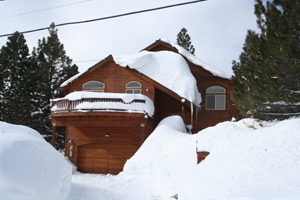
Reduction of Snow Load in Allowable Stress Design
Question 1: The ASD load combinations of the 2012 IBC have an Exception 2 under Sections 1605.3.1 and 1605.3.2 that says to include 20% of the snow load with seismic loads for flat roof snow load that exceeds 30 psf. What exactly does that mean?
Answer 1: The exception is modifying Eqs.16-14 and 16-21. It is saying that S can be taken equal to zero when the flat roof snow load is 30 psf or less. The remainder of the exception is permitting S to be replaced by 0.2S when the flat roof snow load exceeds 30 psf.
This exception was derived from Exception 2 to 1997 Uniform Building Code (UBC) Section 1612.3.2 which reads as follows:
Design snow loads of 30 psf (1.44 kN/m2) or less need not be combined with seismic loads. Where design snow loads exceed 30 psf (1.44 kN/m2), the design snow load shall be included with seismic loads, but may be reduced up to 75 percent where consideration of siting, configuration and load duration warrant when approved by the building official.
Note that the strength design load combinations of 2012 IBC Section 1605.2 do not have such an exception. The basic ASD load combinations of ASCE 7-10 Section 2.4.1 also do not have such an exception. But, of course, the IBC controls, rather than the referenced standard, ASCE 7-10 per IBC Section 102.4.1.
Question 2: Load combination Eq. 16-14 includes 75% of snow load combined with 75% of seismic load. Is the considered snow load in this equation full or 20% based on the above answer?
Answer 2: S is the design snow load as modified by Exception 2. So, it is either zero or 20% of the full design snow load. The basic ASD load combinations of ASCE 7-10 Section 2.4.1, as noted above, do not have that exception. ASCE 7 in fact clarifies that S may be the flat roof snow load or the sloped roof snow load, depending upon the slope of the roof.
Question 3: Equation 16-21 (alternative basic load combination) also uses D+L+S+E/1.4. I have the same question as Q2 about the snow load used.
Answer 3: Same answer as for Q2.
Question 4: The special seismic load combinations of the UBC did not include any snow load. I assume they are replaced by the load combinations with overstrength factor in Section 12.4.3.2 of ASCE 7-10. Is that correct? Snow is included explicitly in these ASCE 7 load combinations. Were we considering any snow load in the UBC in an implicit way?
Answer 4: The IBC through its 2006 edition and the 1997 UBC chose not to include any snow load in their special seismic load combination (the one that is additive rather than counteractive). Section 12.4.3.2 of ASCE 7-10, which was first introduced in ASCE 7-05, does not omit the snow term. The 2009 IBC discarded the special seismic load combinations of the 2006 IBC in favor of referencing ASCE 7-05 Section 12.4.3.2. 2012 IBC Section 1605.1 likewise references ASCE 7-10 Section 12.4.3. Did the special seismic load combination of the UBC and older editions of the IBC implicitly include any snow load? It did only to the extent that QE is the effect of V = CsW and the W must include 20% of the uniform design snow load if the flat roof snow load exceeds 30 psf.
Question 5: In the Basic Combinations for Allowable Stress Design with Overstrength Factor in ASCE 7-10 Section 12.4.3.2, are we using full snow or 20% of snow (for flat roof snow load > 30 psf)?
Answer 5: Full design snow load. There is no exception to this.